You can never have enough DIY devices at home, so when you look at an ESP32 module that comes with the camera, you automatically start getting ideas. [Daniel Padilla] wanted a way to deploy DIY camera modules without the hassle of configuring them so he made one that looks like an access point and starts streaming as soon as you connect to it.[GitHub]
The code he provides allows the ESP32 to appear as an Open Access Point which you can connect to from a PC or smartphone. The awesome sauce here is that the ESP32 resolves all DNS requests to a redirect in a similar manner to what happens when someone connects to an open Wi-Fi access point in a mall, Instead of a captive portal page that asks the user to authenticate or accept terms and conditions, [Daniel Padilla]’s code instead redirects to the streaming page et voila! Instant camera stream, and it is that simple.
We love this project because it is an elegant way to solve a problem, and it also teaches newbies about captive portals and their implementation. We covered a cheap ESP32 Webcam in the past and this project also comes with code for you to get started. We would love to see what you come up with next.




















